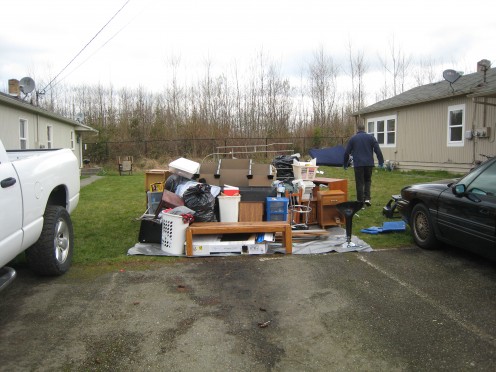The Twenty (20) Day Notice to Terminate Tenancy in Washington State.
The day of physical eviction

Overview
I have been owning/managing properties for over 12 years now. Depending on your location and the tenants you choose you will end up needing to evict someone from your property, it's just part of the business.
Most evictions start because of failure to pay rent and a 3 day to pay or quit (vacate) initiates the legal process. However, there will be times when a 20 day to terminate tenancy will be used to reclaim your property. This can be done only after the lease is up and or a month to month tenancy exist.
I recently just did two, both ending with the Sheriff showing up for a physical eviction. These were awful tenants that I needed to get rid of but they always ended paying their rent so the 3 day to pay or vacate was not available to me. One of the tenants was a long time tenant there. He lived there for about 8 years and about a year ago he started dealing drugs from his unit, hence he had the money to pay rent but was an undesirable tenant that we needed to get rid of. As we had no concrete proof of his drug dealings we decided to use a 20 day to terminate tenancy. As long as their lease is up or on month to month, there is usually no excuse for them to remain on your property past the 20 days, they must move.
There are several reasons why a 20 day to terminate tenancy can be used. Some may be as simple as needing the unit back to make improvements. It's much simpler to make major remodels without someone living there. And some can be more complicated like getting rid of an annoying tenant that constantly breaks the rules that would otherwise be hard to prove in court.
I am not an attorney and these are legal issues that should be consulted with an attorney specializing in landlord tenant laws of your jurisdiction. I am only sharing about my own experiences as a landlord.
The Twenty Day Notice To Termiate
Twenty Day Notice To Terminate. With the notable exception of the City of Seattle, a periodic (month to month) tenancy can be terminated for any reason, except retaliation or discrimination. The tenant only has one choice when served this notice; move out by the end of the rental period. If your rental property is located inside the Seattle city limits, you must comply with Seattle's "Just Cause Ordinance". You may only issue a 20 day notice under very specific conditions in the City of Seattle. Seattle is the only city or county with a "Just Cause Ordinance". However, local laws are continually changing. Check the county and or city ordinances where your property is located to see if there are any ordinances which affect your rental.
A link to read more about Seattle's Just Cause Ordinance: http://www.tenantsunion.org/rights/just-cause-eviction-protection/
Our rentals are not in the Seattle city limits and we use this notice to get rid of problem tenants like the one described above in my overview. The tenants will usually demand a reason for the notice, even to the point of yelling and abuse. We are very steadfast against giving them one fearing it will just make matters worse. We advise the tenant we are following procedure prescribed under the Washington State Law. Both times when the tenant refused to move before the 20 day deadline, our Attorney went into court to get a default judgement. Our Attorney tells us, there is really no excuse they can come up with not to move. Just make sure that your motives are clearly not retaliation or discrimination. If they do fight you in court, be prepared to respond with logical objective business reasons. Such as, documents showing the tenant was continually late with rent, NSF checks, or has been involved in two occasions of disturbances where the police was called.
Serving the 20 Day Notice to Terminate Tenancy
This notice must be given at least 20 days prior to the end of the rental period. Do not count the day you serve the notice. If possible, it is a good practice to allow more than the statutory 20 days. The notice may be served at anytime, provided it meets the 20 day minimum time frame.
There are 3 ways to serve the notice. Make sure you have enough copies of the exact same notice for each of the known residence in the unit.
1. Personal Service: Personally serving it on the tenant.
2. Substitute Service: Take the notice to the rental unit, knock on the door and serve the notice to a "person of suitable age (18 and older) and discretion", then mail a copy of the notice to the tenant. Suitable age and discretion are judgement calls on your part. Never leave a notice with a young child or an individual who is obviously not able to comprehend what is happening. If this is the case, proceed to serve notice by the third method.
3. Posting: Posting the notice on the door and also mailing notices. Make sure to add a few more days to the deadline of the notice because of the delayed time of the mailing.
Here is the language from the RCW (Washington State):
RCW 59.12.040
Service of notice — Proof of service.
Any notice provided for in this chapter shall be served either (1) by delivering a copy personally to the person entitled thereto; or (2) if he or she be absent from the premises unlawfully held, by leaving there a copy, with some person of suitable age and discretion, and sending a copy through the mail addressed to the person entitled thereto at his or her place of residence; or (3) if the person to be notified be a tenant, or an unlawful holder of premises, and his or her place of residence is not known, or if a person of suitable age and discretion there cannot be found then by affixing a copy of the notice in a conspicuous place on the premises unlawfully held, and also delivering a copy to a person there residing, if such a person can be found, and also sending a copy through the mail addressed to the tenant, or unlawful occupant, at the place where the premises unlawfully held are situated. Service upon a subtenant may be made in the same manner: PROVIDED, That in cases where the tenant or unlawful occupant, shall be conducting a hotel, inn, lodging house, boarding house, or shall be renting rooms while still retaining control of the premises as a whole, that the guests, lodgers, boarders, or persons renting such rooms shall not be considered as subtenants within the meaning of this chapter, but all such persons may be served by affixing a copy of the notice to be served in two conspicuous places upon the premises unlawfully held; and such persons shall not be necessary parties defendant in an action to recover possession of said premises. Service of any notice provided for in this chapter may be had upon a corporation by delivering a copy thereof to any officer, agent, or person having charge of the business of such corporation, at the premises unlawfully held, and in case no such officer, agent, or person can be found upon such premises, then service may be had by affixing a copy of such notice in a conspicuous place upon said premises and by sending a copy through the mail addressed to such corporation at the place where said premises are situated. Proof of any service under this section may be made by the affidavit of the person making the same in like manner and with like effect as the proof of service of summons in civil actions. When a copy of notice is sent through the mail, as provided in this section, service shall be deemed complete when such copy is deposited in the United States mail in the county in which the property is situated properly addressed with postage prepaid: PROVIDED, HOWEVER, That when service is made by mail one additional day shall be allowed before the commencement of an action based upon such notice. RCW 59.18.375 may also apply to notice given under this chapter.
So What Happens After Properly Serving the Notice
After serving the notice, you wait until the deadline of the notice, end of the rental period. If the tenant moved out on their own, you take possession and complete the move-in-move-out checklist. In most jurisdictions the deposit statement along with any deposit that is owed the tenat less damages and rental balance needs to be sent to the tenant within so many days, 14 days in Washington State.
If the tenant does not move, then a summons and complaint needs to be served upon the tenant. This is a whole another topic which I will share my experiences in a later blog. Just hit the follow button and you will be notified when it comes out.
As I said before, I am not an attorney and I am simply sharing my experiences as a landlord for the past 12 years. An attorney specializing in landlord tenant law in your jurisdiction should be consulted.









